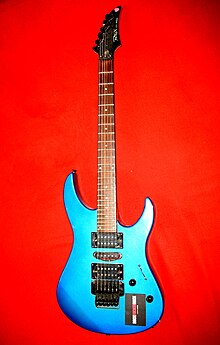| This article needs additional citations for verification. Please help improve this article by adding citations to reliable sources. Unsourced material may be challenged and removed. Find sources: "Yamaha RGX" – news · newspapers · books · scholar · JSTOR (September 2013) (Learn how and when to remove this message) |
| Yamaha RGX | |
|---|---|
 Yamaha RGX521D guitar Yamaha RGX521D guitar | |
| Manufacturer | Yamaha |
| Period | 1987 |
| Construction | |
| Body type | Solid |
| Neck joint | Bolt-on or neck-through |
| Hardware | |
| Bridge | locking vibrato |
| Pickup(s) | H-S-H |
The Yamaha RGX and RGZ electric guitars Series are manufactured by the Yamaha Corporation and bear a close resemblance to the Ibanez RG series, the Jackson Soloist and other "superstrat" enhanced copies of the Fender Stratocaster. These Taiwan-made instruments were introduced in 1987.
RGX Series guitars often have 24 or more frets and a bolt-on neck. Some high-end models use a neck-through-body design. Some come with Yamaha active pickups, in HSS (humbucker/single coil/single coil), HH (dual humbuckers) and HSH (humbucker/single coil/humbucker) configurations.
Most of these instruments were generally known as RGZ, including the RGZ820R, a custom green, red and black plaid (often referred to as "watermelon plaid") graphic model with a Floyd Rose licensed TRS Pro locking tremolo and often retrofitted with Seymour Duncan Parallel Axis Trembucker humbucking pickups (though they came with Yamaha-branded pickups), played by rock guitarist Blues Saraceno.
The RGX guitars were upgraded in 2003 with a 3D headstock sporting a 3+3 tuner layout and a piezo bridge option for acoustic-like tones. Famous endorsees of the RGX/RGZ guitars included Blues Saraceno and Ty Tabor of King's X, who got his namesake RGX-TT and RGX-TTD6 signature models in 2000.
See also
References
- ^ Bacon, Tony (2012). Bailey, Owen (ed.). The Ultimate Guitar Sourcebook. Design by Paul Cooper. New York, NY USA: Race Point Publishing. pp. 166–167. ISBN 978-1-937994-04-4. Retrieved 2013-09-27.